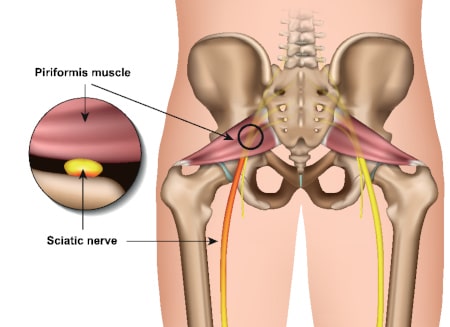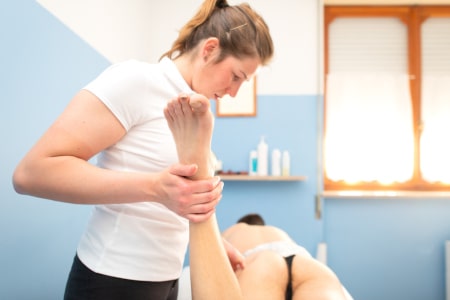What is piriformis syndrome?
Are you bothered by a strange shooting pain in your buttock? Pain that hampers your movement and, for example, turns relaxed long walks into tormenting exercises? If so, you may be suffering from piriformis syndrome.
What is that? Piriformis syndrome is relatively unknown, but it can cause a lot of difficulties. The source is the musculus piriformis, which is Latin for ‘pear-shaped muscle’. This muscle runs from the inside of your pelvis to the back of the hip joint. The piriformis muscle is what allows you to rotate your leg outward.
A long nerve – the nervus ischiadicus or sciatic nerve – runs along the piriformis muscle, or in some cases through the muscle. It goes from the lower back to the leg. When do you suffer from piriformis syndrome? If the piriformis muscle becomes hard or swells up, it presses on the sciatic nerve. This causes a lot of physical discomfort.

Symptoms of piriformis syndrome
The symptoms of piriformis syndrome are very similar to other back disorders. The syndrome is very similar to a hernia, and what’s more, it is regarded medically as a form of sciatica. Piriformis syndrome often starts with a tingling sensation or a numb feeling in the buttock.
As the syndrome increases in severity, the following symptoms can be seen:
- The tingling sensation can radiate to the foot;
- Stabbing sensations at the rear of the legs or thighs;
- Pain in the buttock, mainly deep in the middle of the buttock;
- The pain can radiate to the hip and the leg or thigh;
- The disorder mainly occurs after long periods of sitting, walking, jogging or cycling.
The cause of piriformis syndrome
What is a possible cause of piriformis syndrome? Carrying a thick wallet in the back pocket of your pants. For this reason, the syndrome is also called ‘fat wallet syndrome’. Men suffer the most from this. In the case of women, the syndrome is very common amongst dancers and especially ballerinas, who often have to rotate their thigh outwards. One thing that men and women have in common is that the syndrome usually only occurs at age 40 or later.

What else causes piriformis syndrome, aside from dancing and wallets stuffed full of bank cards and other cards?
- A fall on the gluteal muscle;
- An unsuitable posture;
- Frequent prolonged sitting (at work);
- Overstress as a result of physical work or intensive sports, such as jogging, cycling, rowing, etc.;
- An anatomical anomaly, such as pelvic instability after childbirth.
Piriformis syndrome: a difficult diagnosis
We already mentioned that the symptoms of piriformis syndrome resemble the symptoms of other disorders. This is why a correct diagnosis requires a thorough examination. Doctors first listen to the patient’s complaints and perform a physical examination. Even then, additional investigation is sometimes necessary, ranging from CT scans to a nerve conduction study.
Treatment of piriformis syndrome
There are two basic rules for the treatment of piriformis syndrome. The first, as with other disorders, is that it is very important to stay active. The second is that the earlier the treatment starts, the better the result.
Actually, the treatment of piriformis syndrome anyhow depends on the severity of your complaints. Physiotherapy is usually the first step. Using special exercises, the physiotherapist stretches your piriformis muscle. This relaxes the muscle, reducing its impairment of the sciatic nerve. Sometimes this can also be achieved by massaging the pain point. The physiotherapist may also employ exercises to strengthen the other muscles in the buttock, hip and pelvic region. In consultation with the doctor, physiotherapy may be accompanied by medication, such as paracetamol together with anti-inflammatory pain killers.

A further step is dry needling. In this treatment, a specialised physiotherapist pricks the painful muscle with a needle. This causes the muscle to briefly contract and then relax. This is usually sufficient. But what if it isn’t? Then nerve blocking is another possibility. An anaesthetist administers a local injection of an anaesthetic. Another option is to relax the muscle with a botox injection. Unfortunately, the injection must be repeated every three months.


